35 Traditional Middle Eastern Foods To Try in 2025
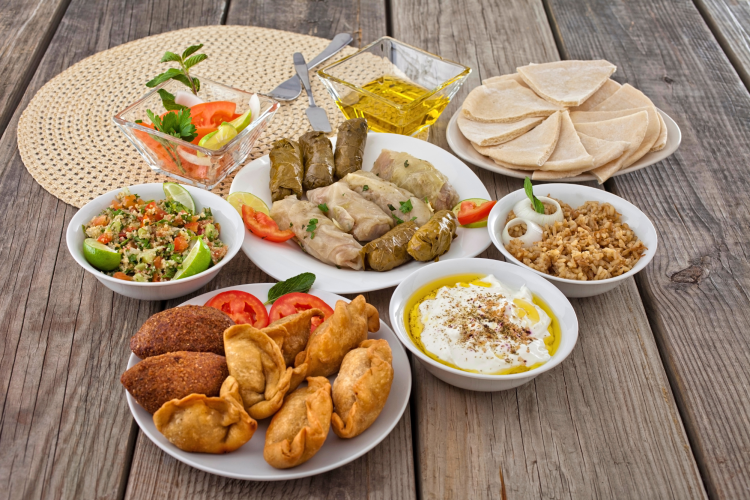
With bold flavors, exotic aroma and compelling traditions, it's no surprise that Middle Eastern foods are celebrated the world over. But what is it about these dishes that keeps everyone coming back for more? Is it the age-old rituals surrounding the preparation? Does the perfect balance of spices and herbs call out to us?
According to IFT, it is in fact the aromatic herbs and spices, which are used to imbue even the simplest of recipes with unique flavors, that play a significant role. Whether it's the warm, comforting bite of a freshly baked flatbread, the zesty taste of a creamy dip, or the sweet drizzle of a sugary treat, Middle Eastern cuisine invites you to experience food that's as soulful as it is delicious.
Are you curious to discover the secrets behind some of the region’s most iconic dishes? Let’s uncover the flavors that have made this cuisine a timeless favorite.
Jump to Section
35 Middle Eastern Foods To Try
1. Tabbouleh
When one thinks of Middle Eastern foods, one usually thinks of delectable meats and sugary desserts. However, across the region, the sheer variety of salads is amazing. Making the most of fresh produce and the cornucopia of herbs and spices on offer, salads like tabbouleh (also spelled as tabouli) are often enjoyed as a first course or a refreshing, light meal on their own.
This refreshing Middle Eastern food consists of bulgur, parsley and mint, along with tomato, feta, lemon juice and onion. Different regions have variations and swap certain ingredients, but on the whole, tabbouleh is served freshly made and tossed just before eating.
If you plan to make this Middle Eastern food at home, remember that there should be an equal or greater proportion of bulgur to the fresh vegetables and herbs. You can leave out the feta if you prefer a vegan option, or opt for lentil tabbouleh instead of bulgur for an added protein boost.
- Pairs With: Grilled kebabs, lamb chops, pita bread.
- Spice Level: Low
- Suitable For: Vegetarians. Can be made vegan-friendly.
- Cooking Notes: Bulgur can be made in advance and stored.
- Where To Buy: Supermarkets and delis.
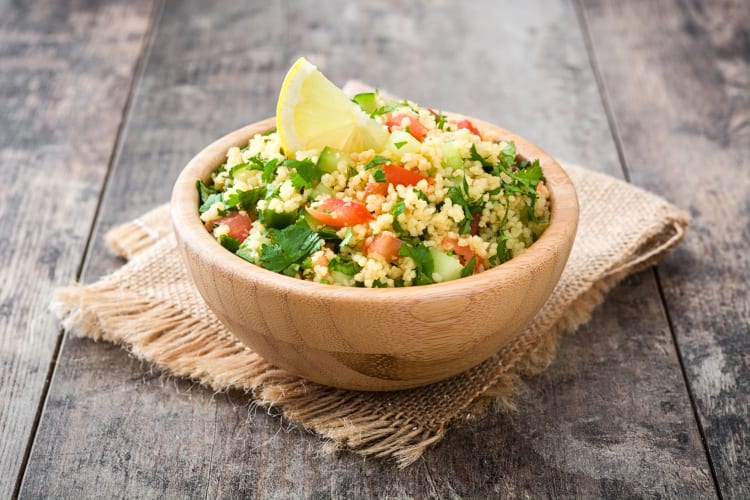
2. Falafel
Many would agree with us that falafel is probably one of the most popular Middle Eastern foods. From high-end dining establishments to street corners, these crunchy, healthy chickpea patties can be found everywhere. Made with soaked and drained chickpeas (or fava beans) that are blended with parsley and/or cilantro, the dough is shaped into balls and fried.
Middle Eastern seasoning and spices ramp up the flavor, and variations abound depending on the region of origin. If you do plan to make falafel at home, always opt for fresh rather than tinned chickpeas for the best results. Stuffed into pita bread, a delicious falafel sandwich is one of the easiest recipes to create with this popular Middle Eastern food.
- Pairs With: Tahini, hummus, toum, fattoush.
- Spice Level: Low to moderate, depending on the spices used.
- Suitable For: Vegetarians, vegans and gluten-free diets.
- Cooking Notes: Use dried chickpeas that have been soaked overnight instead of boiled or canned ones.
- Where To Buy: Supermarkets, delis, street snacks, food trucks.
3. Hummus
As one of the most iconic Middle Eastern foods, authentic hummus (also known as chummus) is made with cooked chickpeas blended with garlic into a smooth spread and served as a meal with fragrant olive oil and a dusting of herbs and spices. A squeeze of lemon juice and some raw onions add to the medley of flavors.
When making this Middle Eastern food at home, be it regular or spicy hummus, a secret trick is to remove the skin of the chickpeas before blending for the smoothest results. Add hot water or olive oil to loosen the dip and sprinkle on the spices only after completely blended and ready to serve.
- Pairs With: Tahini, toum, tabbouleh, pita bread.
- Spice Level: Low to moderate, depending on the spices used.
- Suitable For: Vegetarians, vegans and gluten-free diets.
- Cooking Notes: For a lighter, fluffier texture, slowly add a few tablespoons of ice-cold water when blending the hummus.
- Where To Buy: Supermarkets, delis, street snacks, food trucks.
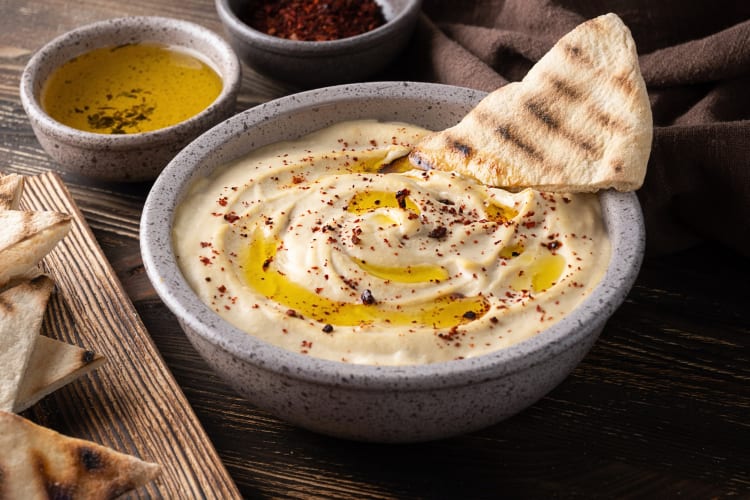
4. Shawarma
A Levantine classic, shawarma is among the most beloved Middle Eastern foods and can be found all over the region. At its root, it consists of thinly sliced meat stacked on a vertical spit. Sometimes, vegetables such as tomatoes or peppers are placed between the meat layers for extra flavor.
The spit rotates near a heat source for hours, slowly grilling and roasting the meat. A thin, long knife is used to shave wafer-thin slices, which are then stuffed into a pita, rolled as a wrap or served up on a plate with vegetables and fries. You'll generally find this Middle Eastern food made of beef or chicken, but some restaurants also offer a combination of meats.
- Pairs With: French fries, pickled turnips, pickled carrots.
- Spice Level: Moderate to high, depending on the spices used.
- Suitable For: Meat-eaters and high-protein diets.
- Cooking Notes: Marinate the meat overnight for extra flavor.
- Where To Buy: Street snacks, food trucks, restaurants.
5. Shakshouka
Shakshouka, derived from the Arabic word meaning "mixture," is the quintessential make-it-as-you-go Middle Eastern Food that's enjoyed worldwide. Every good shakshouka starts with onions and tomatoes — the chunkier and juicier, the better. As the tomatoes cook down into a thick sauce, peppers and chiles may or may not be added.
Once the sauce is thick and unctuous, the eggs are broken into shallow puddles and the dish is covered for mere minutes before being served up. This results in golden, runny yolks ready to be mopped up with crusty bread.
While the origins of this Middle Eastern food point towards North Africa, today it is more or less considered the national dish of Israel. In Turkey, a similar meal called menemen is relished for breakfast, lunch and dinner, featuring scrambled eggs instead.
- Pairs With: Pita bread, baguettes, tortilla.
- Spice Level: Moderate to high, depending on the spices used.
- Suitable For: Vegetarians and high-protein diets.
- Cooking Notes: Use a spoon to create wells for the eggs.
- Where To Buy: Restaurants, breakfast cafés.
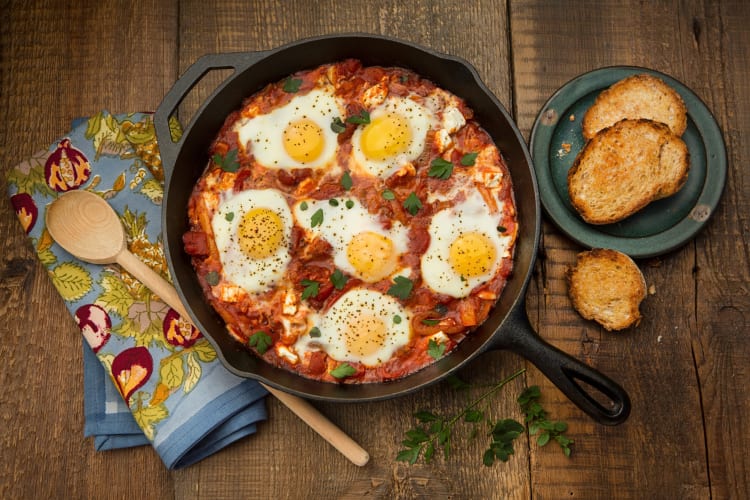
6. Turkish Coffee
A beloved Middle Eastern food, Turkish coffee is enjoyed during various traditions. It is made from finely ground coffee beans, combined with water and sugar. When the mixture is heated to just below boiling in special pots called cezves, the liquid bubbles up to a frothy concoction.
This brew is then ladled into tiny two-ounce cups, and the coffee grinds sink to the bottom. Now, here’s an essential tip: Never, ever stir your Turkish coffee before drinking it — you will be assured of a bitter, unpalatable beverage. The grounds that settle to the bottom of the cup are often read by a fortune teller (as an enjoyable ritual that adds to the theatrical nature of serving this popular drink).
- Pairs With: Cardamom, sugar cubes, baklawa.
- Spice Level: None
- Suitable For: Vegetarians, vegans and lactose-intolerant diets.
- Cooking Notes: Heat slowly instead of boiling.
- Where To Buy: Restaurants, street food stalls, markets, traditional cafés.
7. Adana Kebab
Adana is known as the fifth-largest city in Turkey and is also home to one of the most delicious Middle Eastern foods. The Adana kebab is considered a protected regional dish and comes with a lengthy list of instructions on how to make it, the ingredients that can be officially used and how it needs to be served.
Needless to say, trying to recreate this magic anywhere outside the city of origin is almost impossible. But that doesn’t stop chefs around the world from trying.
The best versions of this Middle Eastern food are made from young lamb meat that is chopped and grilled on lengthy skewers over open coals. Shaped into slightly flattened and wavy kebabs, the grilled meat is sprinkled with a mixture of sumac, cumin and salt, and served alongside an onion and parsley salad, as well as lavash bread.
- Pairs With: Lavash bread, roasted chile pepper, parsley salad.
- Spice Level: Moderate to high, depending on the spices used.
- Suitable For: Meat-eaters and high-protein diets.
- Cooking Notes: Mix and shape the seasoned meat while it's cold.
- Where To Buy: Restaurants, street food stalls.
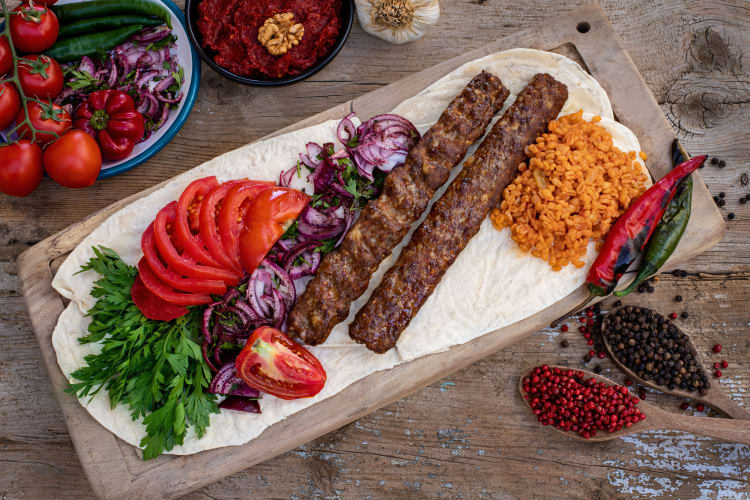
8. Khan Plov
Rice pilaf is one of the more in-demand Middle Eastern Foods, with each region producing its distinctive variant. Khan plov, a variant of pilaf, is the national dish of Azerbaijan, made with saffron-infused rice, lamb and chicken, together with nuts and dried fruits.
It is wrapped in lavash that is saturated with butter, forming a thin, crispy brown shell casing. The shell is then cracked open on the dish, with the fragrant pilaf spilling out to the mesmerized stares of the diners. It is one of those traditional Middle Eastern foods that needs to be experienced at least once to be fully appreciated.
- Pairs With: Yogurt-based drinks, pickled vegetables, cilantro, cucumber salad.
- Spice Level: Mild
- Suitable For: Meat-eaters
- Cooking Notes: Brush the pot used to cook the lavash with butter or ghee.
- Where To Buy: Traditional Azerbaijani restaurants.
9. Ayran
After consuming a diet rich in meat and fat, the need of the hour is for a cooling, digestive drink. And this is where the people of Turkey deliver in spades. Ayran is a yogurt drink that is the perfect antidote for a spicy, heavy meal. Among Middle Eastern foods, Turkish ayran is compelling in its simplicity.
Made with just yogurt, water and salt, this beverage works as a digestive aid thanks to its probiotic nature and as a preventative against dehydration. Ayran is packed with nutrients, electrolytes (due to its salty flavor) and minerals.
- Pairs With: Any Middle Eastern foods
- Spice Level: None
- Suitable For: Vegetarians
- Cooking Notes: For a refreshing drink, make sure to use ice-cold yogurt and water.
- Where To Buy: Restaurants, street food stalls, delis, supermarkets.

10. Masgouf
One of the more unusual Middle Eastern foods is masgouf, which is essentially a grilled carp. While this is not the most sought-after fish in the region, if prepared properly, it can be a treat for the taste buds.
It needs to be slow-cooked for a few hours to get rid of the fat. When served with lemon, pickles and salad, it becomes an entire culinary experience in itself; one of those Arabic foods that surprises everyone who tries it.
- Pairs With: Pickled vegetables, flatbread, sumac onions, tomato-cucumber salad.
- Spice Level: Mild to moderate
- Suitable For: Pescatarians, gluten-free diets.
- Cooking Notes: Marinate the fish for at least an hour before cooking.
- Where To Buy: Authentic Iraqi restaurants, Middle Eastern food festivals.
11. Toum
Imagine the creamiest, most appetizing mayonnaise, and now picture it without eggs. Toum is what you are thinking of. This spicy, punchy vegan-friendly sauce is a garlic-lover's dream. A staple in Lebanese cuisine, this is one of those Middle Eastern foods that complements any dish.
Add it to salads, dollop it into soups or stews, slather it on sandwiches or wraps or simply use it as a dip with fresh vegetable sticks — there’s nothing that toum doesn't make better. If you plan to whip up a batch of this Middle Eastern food at home, you could go old-school with a mortar and pestle, or use a food processor for convenience. Just make sure the garlic you use is firm and fresh for the smoothest, creamiest texture.
- Pairs With: Grilled meat, shawarma, sabich, baked potatoes.
- Spice Level: Low
- Suitable For: Vegetarians, vegans, dairy-free and gluten-free diets.
- Cooking Notes: Add oil slowly when blending.
- Where To Buy: Restaurants, street food stalls, delis, supermarkets.
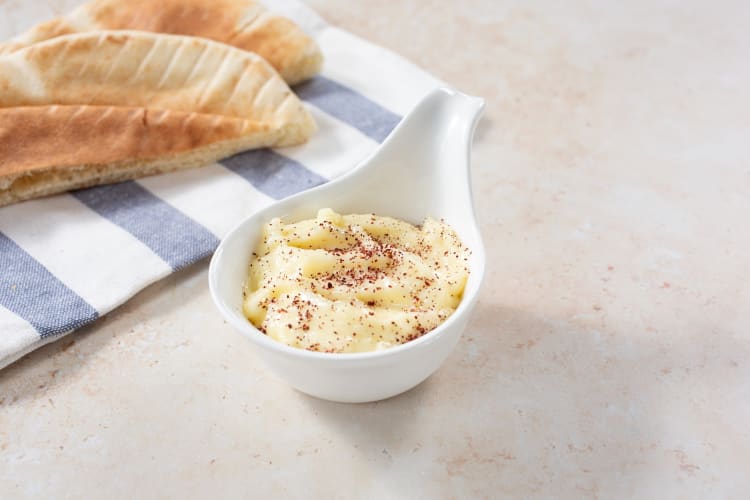
12. Halva
When it comes to sweet dishes, Middle Eastern foods are full of surprises. There are the milk-based puddings, the mastic-enhanced ice creams and nut-filled treats. And then you have halva, one of the traditional Arabic foods that features tahini (the popular sesame seed spread of the region), cooked down into a thick paste that then cools and sets into an almost fudge-like consistency.
By itself, halva is not overly sweet, but it can be tweaked to suit personal taste preferences with the addition of nuts, dried fruit or chocolate. There are versions of this Middle Eastern food in several countries, varying in terms of ingredients used.
For example, Iranian halva is made of flour, while the Greeks use semolina. This sweet concoction has been popular for over 1,000 years, and all it takes is one bite to understand why.
- Pairs With: Coffee, tea and other Middle Eastern foods on a dessert board.
- Spice Level: None
- Suitable For: Vegetarians, vegans, dairy-free and gluten-free diets.
- Cooking Notes: Lightly toast the flour or semolina before adding syrup.
- Where To Buy: Restaurants, street food stalls, delis, supermarkets, sweet stores.
13. Kibbeh
You may have noticed these torpedo-shaped fried treats in street food stalls or Arabic markets. Known as kibbeh (or kubbeh), this is Middle Eastern food at its best. Made from a mixture of lamb or beef — traditionally, even camel meat was used — kibbeh are similar to falafel in shape and crunchy texture.
However, taste-wise, kibbeh is infinitely richer. This popular snack has the added zing of baharat or seven spice powder, roasted pine nuts, pomegranate molasses and bulgur. You could try and make this Middle Eastern food at home, but be warned, achieving the perfect shape and crunch can be daunting.
- Pairs With: Salad, pita bread, yogurt.
- Spice Level: Low to moderate
- Suitable For: Vegetarians, vegans and dairy-free diets.
- Cooking Notes: Use chilled ingredients to shape the shells.
- Where To Buy: Restaurants, street food stalls, delis, supermarkets.
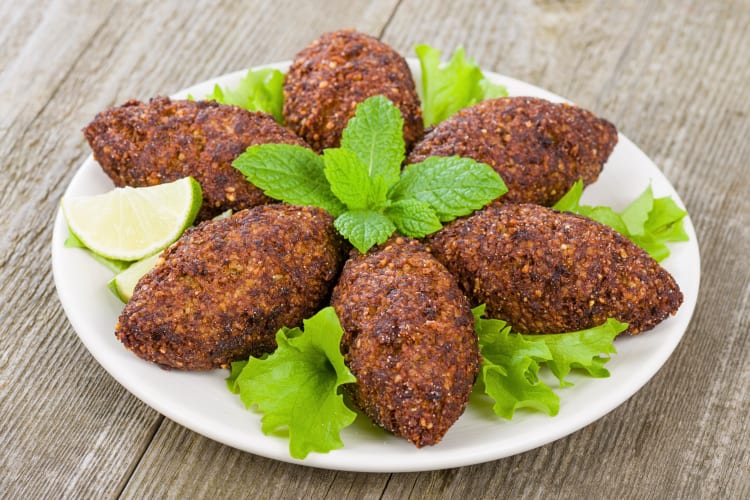
14. Couscous
Couscous is a staple accompaniment to most Middle Eastern foods. Celebrated for its subtle (and neutral) flavor, it offers the perfect blank canvas for any number of main dishes. Made from semolina wheat rolled into tiny grains, couscous is steamed (or soaked in boiling water) and fluffed up to a light, airy texture.
You can find couscous served with Middle Eastern foods such as spicy stews, grilled meats, roasted vegetables or simply tossed with olive oil and herbs. One of our favorite ways to use it is to toss it with vegetables, chickpeas and tofu for a power-packed, easy vegan bowl that makes a delicious lunch.
- Pairs With: Grilled meat, salad, roasted vegetables, yogurt sauces.
- Spice Level: Low to moderate
- Suitable For: Vegetarians, vegans and dairy-free diets.
- Cooking Notes: Use a fork instead of a spoon to fluff, which helps prevent it from getting mashed.
- Where To Buy: Restaurants, street food stalls, delis, supermarkets, online specialty stores.
15. Muhammara
Among the long line of delicious and distinctive Middle Eastern foods, there is a spread that is so versatile that it wouldn’t be a surprise if it soon surpassed hummus in terms of popularity. Muhammara, one of the best Arabic foods for all occasions, uses smoky, charred red peppers as the base, along with nuts such as walnuts or pine nuts, breadcrumbs and pomegranate molasses.
Herbs and spices, such as chile flakes, cilantro, mint or parsley, add color and depth to an already tart and creamy spread. Muhammara can be enjoyed on its own as a dip or as part of a mezze. Some versions of this Middle Eastern food play around with using roasted eggplant or other vegetables instead of or along with the red peppers.
- Pairs With: Grilled meat, shawarma, sabich, fresh vegetables, baked potatoes.
- Spice Level: Low to moderate
- Suitable For: Vegetarians, vegans, dairy-free and gluten-free diets.
- Cooking Notes: Roast the nuts and peppers before blending them.
- Where To Buy: Restaurants, street food stalls, delis, supermarkets.
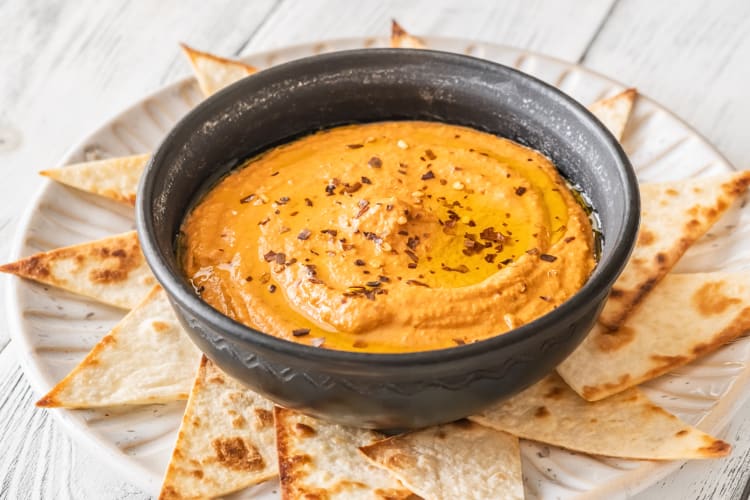
16. Sabich
Today, sabich is one of Israel’s most beloved street foods, but its roots can be traced back to the Iraqi Jewish immigrants who arrived in the 1940s and '50s. This multi-layered sandwich, now a revered Middle Eastern food, was initially created as a practical Shabbat breakfast assembled from cold leftovers.
The original version of this Middle Eastern food layers fried eggplant, hard-boiled eggs and Israeli salad, as well as parsley, tahini and a tangy mango pickle called amba, inside Iraqi laffa. This cold sandwich, with its many textured layers, is the perfect medley of soft, creamy, sharp, pungent, and fresh flavors.
Some modern sabich versions often use pita and alternative fillings such as boiled potatoes, zhug (a fiery green sauce) or hummus. You can even find this Middle Eastern food deconstructed and served in a bowl for a healthy, low-carb meal.
- Pairs With: Salad, pickled vegetables, fried eggplant, boiled potatoes.
- Spice Level: Mild to spicy, depending on additions like zhug or hummus.
- Suitable For: Vegetarians. Can be made vegan-friendly.
- Cooking Notes: Layer the ingredients strategically to get the most out of every bite.
- Where To Buy: Restaurants, street food stalls, delis, supermarkets.
17. Manakeesh
Manakeesh is a beloved Levantine flatbread, often described as the pizza of Middle Eastern foods. The most popular version of this handmade bread is za'atar manakeesh. Za'atar is a spice mix made from thyme, sumac and sesame seeds, which is slathered on the dough before being baked in a traditional oven.
Manakeesh is a golden, aromatic breakfast staple in Lebanon, Jordan and Syria. Eaten hot from a street bakery and folded like a sandwich, this Middle Eastern food is portable comfort food at its best. Though cheese and meat varieties exist, the za'atar version remains the most popular.
- Pairs With: Grilled meat, salad, kebabs, labneh.
- Spice Level: Mild
- Suitable For: Vegetarians and dairy-free diets. Can be made vegan-friendly.
- Cooking Notes: Knead the dough and let it rest twice for a better texture.
- Where To Buy: Restaurants, street food stalls, delis, supermarkets, specialty grocery stores, bakeries.
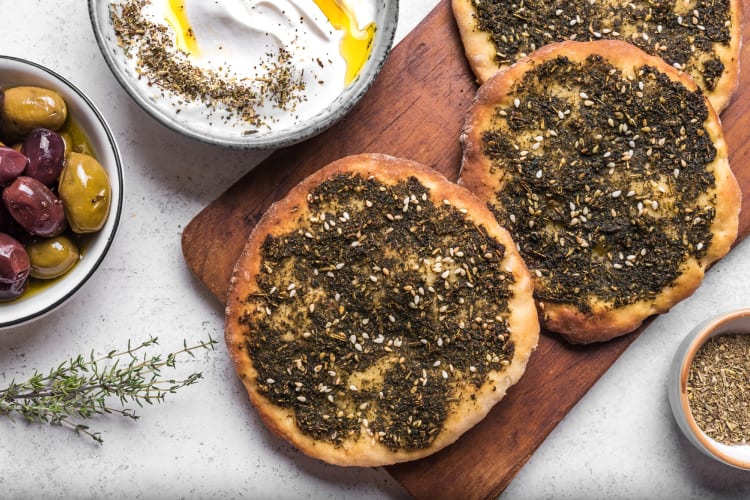
18. Moutabal
One of the Middle Eastern foods that is truly amazing when made from scratch is moutabal. We love it because it is relatively simple to make. All you need to do is smoke some eggplant, mix it with tahini, garlic and a bit of lemon juice, and it is good to go. Whether you have this Middle Eastern food with pita, add it to a mezze or serve it with a shish kebab is up to you; either way, you're in for a treat.
- Pairs With: Grilled meats, roasted vegetables and other Middle Eastern foods on a mezze platter.
- Spice Level: Mild, but can be adjusted.
- Suitable For: Vegetarians, vegans and gluten-free diets (use gluten-free pita).
- Cooking Notes: Make sure the eggplant is charred well for a smoky flavor.
- Where To Buy: Middle Eastern grocery stores, specialty delis, select supermarkets.
19. Shish Kebab
A signature Turkish food that is one of the most popular meals on this list, the shish kebab has a long history dating back to ancient Greece. The modern-day versions of this Middle Eastern food come in several types and use different meats, marinades and sauces.
Lamb is the most common shish kebab you'll find, but other meats, such as chicken, can also be used. The skewers used for this Middle Eastern food are usually made from stainless steel, and the pieces of meat are uniformly cut so that they finish cooking at the same time. They are usually marinated for a day before being cooked, preferably over a coal fire.
- Pairs With: Moutabal, hummus, flatbreads, rice pilaf.
- Spice Level: Moderate
- Suitable For: Meat lovers, low-carb and paleo-friendly diets.
- Cooking Notes: Don't add too many acidic ingredients to the marinade.
- Where To Buy: Turkish or Middle Eastern restaurants, specialty butchers, gourmet grocery stores.
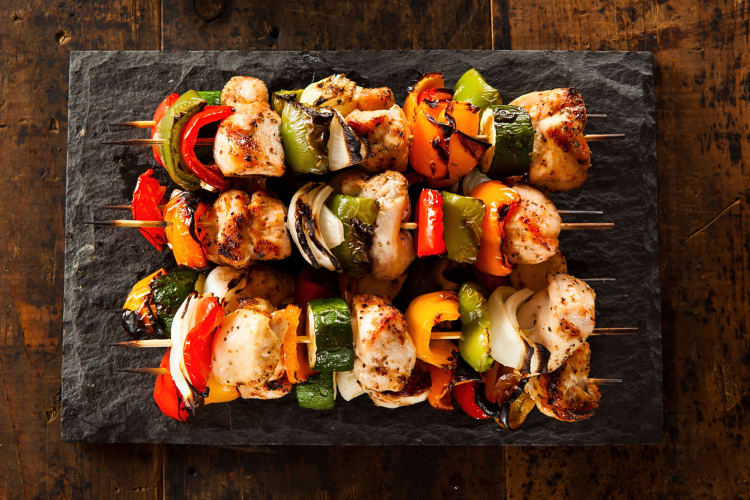
20. Knafeh
One of the most delicious Middle Eastern foods, second only to baklawa, in our opinion, is knafeh. Just a handful of ingredients is all it requires to make one of the best Middle Eastern foods that would delight any lover of sweets.
With its wonderful, layered, crispy pastry and sweet cheese that is soaked in sugar syrup, this dessert, which originated long ago in Nablus, is something that will give you a delicious sugar high.
- Pairs With: Strong black Arabic coffee, mint tea, cardamom-spiced milk and other Middle Eastern foods on a dessert board.
- Spice Level: None
- Suitable For: Vegetarians
- Cooking Notes: Let the sugar syrup cool completely before adding it to the pastry.
- Where To Buy: Middle Eastern bakeries, dessert shops, Levantine restaurants, Mediterranean grocery stores.
21. Halloumi
It's a well-known fact that Middle Eastern foods feature a rich variety of cheeses, and halloumi is one of them that has become increasingly popular. A cheese that can be grilled or fried without melting, it can be grilled until golden-brown and still retain its shape. While it was originally made with sheep or goat's milk, today, cow's milk is also used.
- Pairs With: Watermelon, pita bread, hummus, tabbouleh.
- Spice Level: None
- Suitable For: Vegetarians, low-carb and keto diets.
- Cooking Notes: Dry each slice with a paper towel before cooking.
- Where To Buy: Supermarkets, Mediterranean delis, cheese counters, specialty food stores.
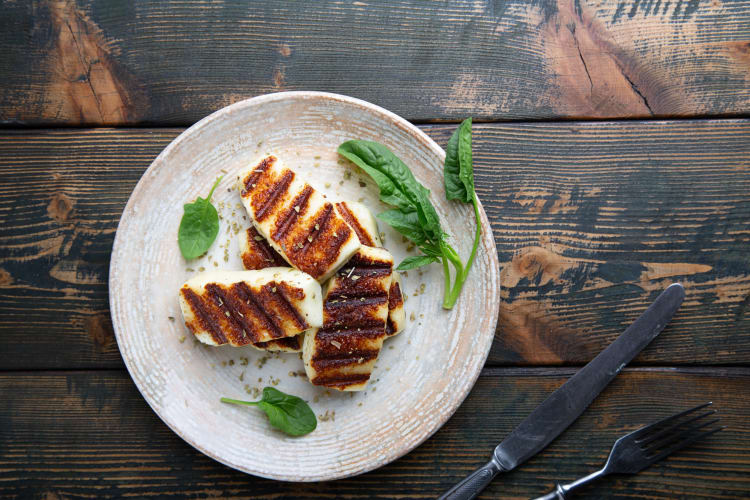
22. Fattoush
Most Middle Eastern foods are served with accompanying salads, dips and sides, and fattoush is a popular Lebanese salad that falls into this category. Made from crunchy pita pieces mixed with lettuce, cucumber and tomato, along with radish, green onion and bell pepper, it is usually tossed with a lemon dressing. Other vegetables or dressings may also be added to this hodgepodge mix as desired.
- Pairs With: Grilled meats, falafel, lamb stew, shawarma.
- Spice Level: Mild
- Suitable For: Vegetarians, vegans and Mediterranean diets.
- Cooking Notes: Toast the pita bread for extra crispness before tossing it with the other ingredients.
- Where To Buy: Lebanese or Middle Eastern restaurants, specialty delis.
23. Mansaf
Mansaf is a unique Middle Eastern food that seems similar to pizza but is quite distinct from it. It originates in Jordan and has a multitude of flavors and textures from the lamb or mutton, which sits atop a rich, creamy yogurt and is topped with a drizzle of pine nuts and almonds.
The meat is slow-cooked and very tender, full of flavor and easy to chew. While Mansaf can be served on a plate, this traditional Arabic food is usually served at celebrations on the table itself.
- Pairs With: Simple salads, pickled vegetables, laban.
- Spice Level: Mild to moderate
- Suitable For: Meat-eaters and high-protein diets.
- Cooking Notes: Dissolve and blend the yogurt thoroughly before adding it to the dish.
- Where To Buy: Jordanian or Levantine restaurants, Middle Eastern food festivals.
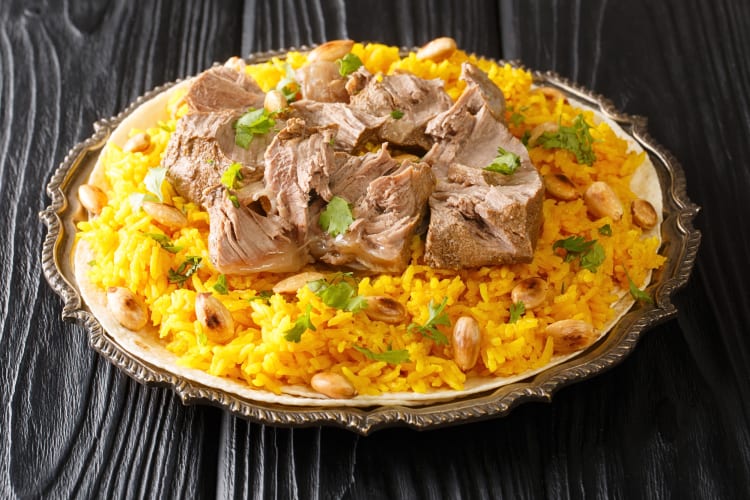
24. Kuku Sabzi
Another Middle Eastern Food that originated in Iran, kuku sabzi is a traditional Persian omelette usually served on the Persian New Year, also known as Nowruz. It is rich in symbolism, with the eggs embodying fertility and the herbs (sabzi) representing rebirth.
Crushed nuts may be added to give this Middle Eastern food a crunch, and barberries for an added sour tang. It is easy to prepare and is usually served as a side dish or as a sandwich filling.
- Pairs With: Flatbread, yogurt-based dips, torshi, green salad.
- Spice Level: Mild
- Suitable For: Vegetarians, high-protein diets.
- Cooking Notes: Chop the herbs very finely for a light texture.
- Where To Buy: Persian restaurants, bakeries, specialty Iranian grocery stores.
25. Chelo Kebab
One of the most beloved Middle Eastern foods is the kebab, and chelo kebabs are a traditional Persian dish that has an appeal to audiences far and wide. The succulent meat, usually lamb or beef, with their unique smoky flavor, perfectly complements the fragrant rice base known as “chelo.”
The meat is marinated for hours in aromatic spices, like many of the best Middle Eastern foods. The spices used include saffron, paprika and turmeric, as well as cumin and garlic, and the meat is grilled until it is very tender.
- Pairs With: Grilled tomatoes, sumac, mast-o-khiar, flatbread.
- Spice Level: Moderate
- Suitable For: Meat-eaters and high-protein diets.
- Cooking Notes: For the juiciest flavors, marinate the meat for at least four hours.
- Where To Buy: Persian restaurants, Middle Eastern grills, specialty food stores.
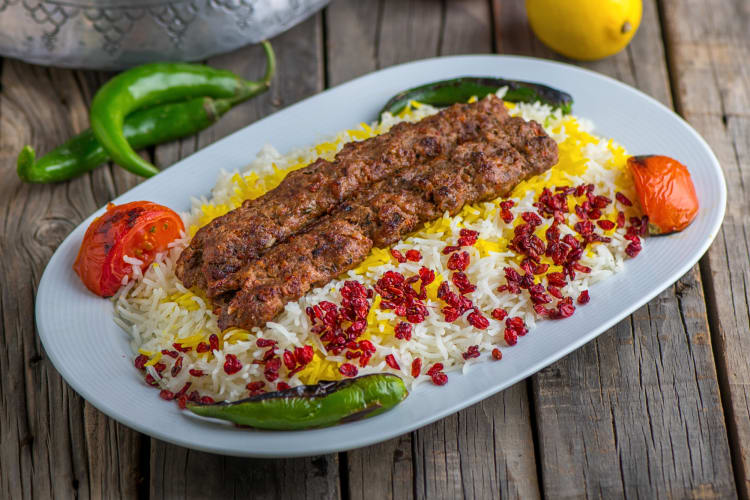
26. Torshi Seer
A Persian staple served as a side with many Middle Eastern foods, torshi seer is the name for garlic pickled in vinegar and salt. Its sweetness and acidity help in balancing out the flavors of Persian food.
The garlic used in this Middle Eastern food has to be pickled for at least a year before being served; the longer the period, the sweeter the taste. The color of the garlic cloves transforms during the pickling process, eventually fading to a light brown and slowly darkening over time.
- Pairs With: Kebabs, stews, rice dishes, cheese.
- Spice Level: Mild
- Suitable For: Vegans, vegetarians.
- Cooking Notes: Use a high-quality vinegar with a minimum of 5% acidity.
- Where To Buy: Persian or Middle Eastern grocery stores, traditional bazaars.
27. Dolma
Iraqi dolma is one of the many rice-based Middle Eastern foods that have innumerable variations, even within the country. Dolma is a stuffed vegetable dish, consisting primarily of rice mixed with ground lamb or beef, diced vegetables and tomato paste, together with pomegranate molasses and spices. Each bite of this Middle Eastern food melts in your mouth with a burst of tart, sweet, umami flavor — simply delicious.
- Pairs With: Plain yogurt, garlic labneh, flatbread, pickled vegetables.
- Spice Level: Mild to moderate
- Suitable For: Meat-eaters and Mediterranean diets. Vegetarian versions are common.
- Cooking Notes: Briefly blanch the leaves in hot water before filling them.
- Where To Buy: Middle Eastern restaurants, delis, traditional markets, specialty or Mediterranean grocery stores.
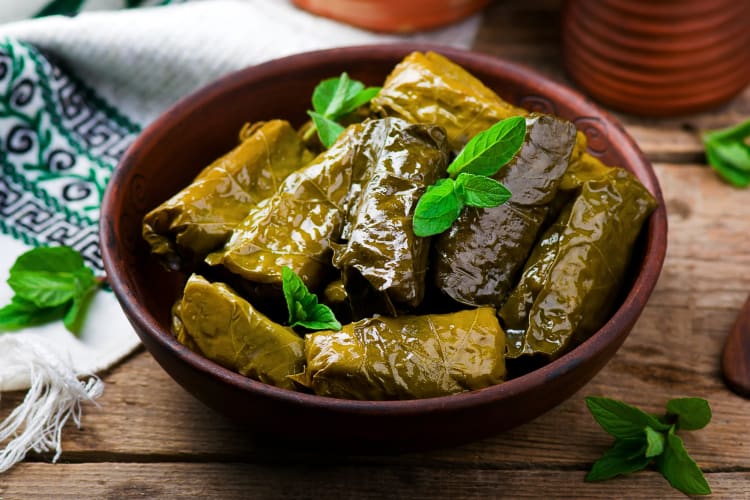
28. Shankleesh
If you're hoping to find a Middle Eastern food similar to blue cheese, shankleesh is your best bet. It is the only aged cheese from the region and can be found in most grocery shops.
It is commonly served as part of a mezze spread, along with other traditional Middle Eastern foods, placed together with parsley, diced tomatoes and onions, and drizzled with plenty of extra-virgin olive oil. Its tangy, pungent bite will keep you coming back for more.
- Pairs With: Warm pita bread, olives, labneh, arak.
- Spice Level: Moderate
- Suitable For: Vegetarians, cheese-lovers.
- Cooking Notes: Not cooked
- Where To Buy: Levantine grocery stores, Middle Eastern delis, specialty food shops.
29. Turkish Delight
A treasure of the Ottoman Empire kitchens, Turkish delight (or lokum) is a delectable confection that captivates people from the first bite. Chewy, sweet, and full of flavor and texture, this treat is considered the pinnacle of Middle Eastern foods.
One of the tastiest Arabic foods for those with a sweet tooth, made with rosewater, pomegranate, lemon and mastic, the jelly-like cubes are dusted with icing sugar or desiccated coconut to prevent sticking. A part of cultural celebrations and festive tables, such as Ramadan and Eid, today, this Middle Eastern food is available throughout the year.
Modern iterations of this Middle Eastern food include nuts like pistachio and walnut, and play around with sophisticated flavors such as berry, chocolate and herbs, like bergamot.
- Pairs With: Coffee, tea and other Middle Eastern foods on a dessert board.
- Spice Level: None
- Suitable For: Vegetarians, vegans and halal diets (as per the original ingredients when made in Turkey).
- Cooking Notes: For accurate temperature measurement during cooking, use a candy thermometer.
- Where To Buy: Restaurants, street food stalls, delis, supermarkets, sweet shops.

30. Shish Taouk
A skewered chicken dish that has become a quintessential Middle Eastern food, shish tawook features tender pieces of chicken that have been marinated in spices, yogurt, lemon juice and garlic. As you may have guessed, the flavor of the dish lies in the marinade and the spices used.
You can enjoy it as a sandwich, rolled in a pita bread or served with rice and vegetables, along with fries and sauce. It is one of the more popular Arabic foods, especially for casual, outdoor gatherings.
- Pairs With: Pickles, tabbouleh, fattoush, rice pilaf, warm pita.
- Spice Level: Mild to moderate
- Suitable For: Meat-eaters, halal diets and protein-rich diets.
- Cooking Notes: Marinate the chicken for at least 6 hours before cooking.
- Where To Buy: Lebanese and Middle Eastern restaurants, food trucks, shawarma stands, grocery stores, butcher counters.
31. Baklawa
Don’t be confused into thinking baklava (Greek) and baklawa (Middle Eastern) are the same thing. While similar in concept, the syrup used is completely different. But if you enjoy the Greek version, you'll love this Middle Eastern food just as much, if not more.
Baklawa (and here we include Syrian and Lebanese) is made with layers of golden filo pastry and stuffed with walnuts. The entire platter is then drizzled with warm butter and baked till crisp.
Once out of the oven, an orange blossom or rose water syrup is poured over and left to cool. Surprisingly lighter than its Mediterranean counterpart, this is one of the most delicious Middle Eastern foods and can be enjoyed as a dessert or a sweet afternoon snack with a piping hot cup of coffee or tea. More experienced cooks can try their hand at desserts like baklava cheesecake for a showstopper end to a meal.
- Pairs With: Coffee, tea, ice cream and other Middle Eastern foods on a dessert board.
- Spice Level: None
- Suitable For: Vegetarians
- Cooking Notes: Slice before baking for even distribution of heat.
- Where To Buy: Restaurants, street food stalls, delis, supermarkets.
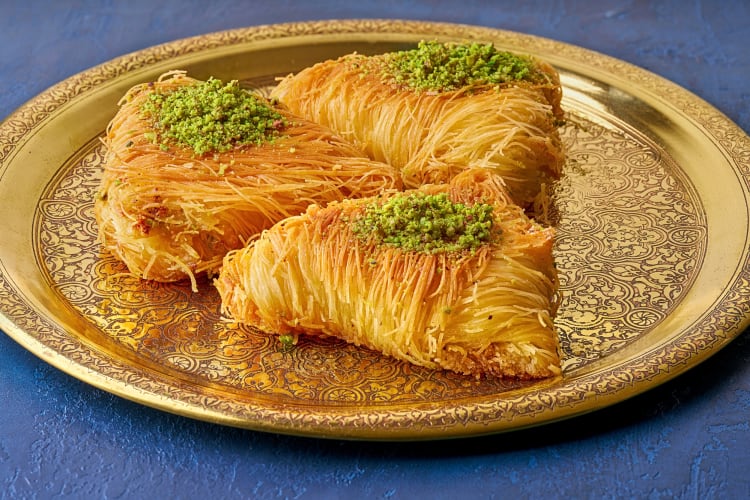
32. Quwarmah Al Dajaj
There are not too many Middle Eastern foods that are curry-based, but the Kuwaiti curried chicken is one such dish. With its unique blend of Middle Eastern flavors, this dish is one of the best Arabic foods for a chilly night, distinct from its Indian counterparts.
With a delicate blend of lime, ginger and turmeric, together with cardamom, cinnamon and nutmeg, you'll be surprised to know that this Middle Eastern food doesn’t overload your palate with flavor. Rather, the subtle flavors become a treat to the senses.
- Pairs With: Rice, Arabic bread, pickled onions, chilled yogurt salad.
- Spice Level: Mild to moderate
- Suitable For: Meat-eaters
- Cooking Notes: Toast the spices briefly in ghee or oil before adding the chicken.
- Where To Buy: Traditional Kuwaiti or Gulf-region restaurants.
33. Fatayer
Many Middle Eastern foods bear more than a passing resemblance to those from neighboring countries and cultures, and fatayer is one of them. These spinach pies are the Lebanese equivalent of the Greek spanakopita, made from a simple homemade dough that has been stuffed with spinach, herbs and lemon filling.
They are then baked until golden-brown for a delectable, crispy outer layer. The recipe has many variations that use different ingredients, including cheese and ground beef. This is one of those Middle Eastern foods you can experiment with to suit your taste preferences.
- Pairs With: Labneh, hummus and other Middle Eastern foods on a mezze platter.
- Spice Level: Mild
- Suitable For: Meat-eaters. Can be made vegetarian-friendly.
- Cooking Notes: After kneading, let the dough rest for 30 minutes before shaping it.
- Where To Buy: Middle Eastern bakeries, Lebanese delis, international sections of supermarkets, specialty grocery stores.
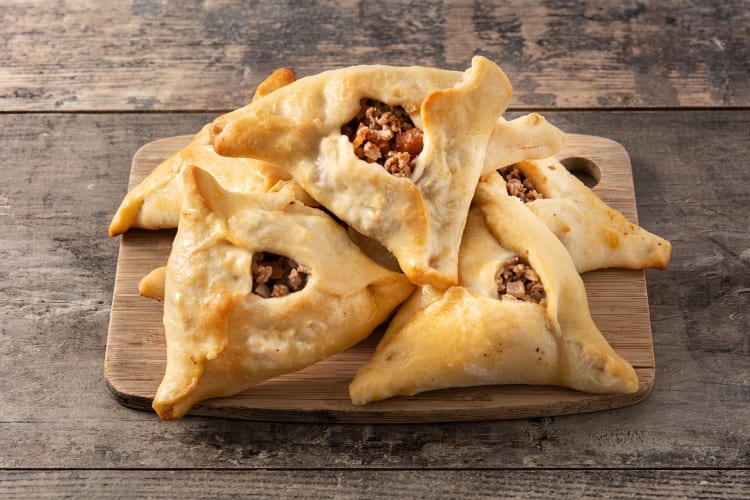
34. Shorabit Jarjir
The use of lentils in Middle Eastern foods dates back millennia, all the way to ancient Greek and Egyptian civilizations. Shorabit jarjir, or “shorbat adas” in Arabic, is one of the most enjoyable Middle Eastern foods for vegetarians and vegans.
It is usually served with lemon juice and crispy onions, and can have different variations depending on the region in which it is served; for example, the Lebanese version may have vegetables added. If you want to try making it at home, you can experiment with different varieties, or you could go with a simple vegan lentil soup for a filling, hearty meal that never disappoints.
- Pairs With: Pita bread, pickled turnips, fattoush, cucumber yogurt salad.
- Spice Level: Mild
- Suitable For: Vegetarians, vegans and gluten-free diets.
- Cooking Notes: For added flavor, sauté onions and garlic in olive oil before adding the other ingredients.
- Where To Buy: Middle Eastern restaurants, international grocery stores.
35. Ful Medames
When people don't feel like eggs, a tasty Middle Eastern food that's enjoyed in the morning is ful medames. This stew is one of the popular Arabic foods made from fava beans, chickpeas and spices.
An easy dish to make, this Middle Eastern food can be prepared in under 20 minutes using only a handful of ingredients. It is served with sides like chopped parsley, onions and pepper.
- Pairs With: Warm pita, hard-boiled eggs, pickled vegetables, Arabic coffee or tea.
- Spice Level: Mild
- Suitable For: Vegetarians, vegans and protein-rich diets.
- Cooking Methods: Cook the fava beans for several hours or overnight for a creamy texture.
- Where to Buy: Egyptian, Lebanese and Syrian restaurants or cafés, as well as Middle Eastern or international supermarkets.
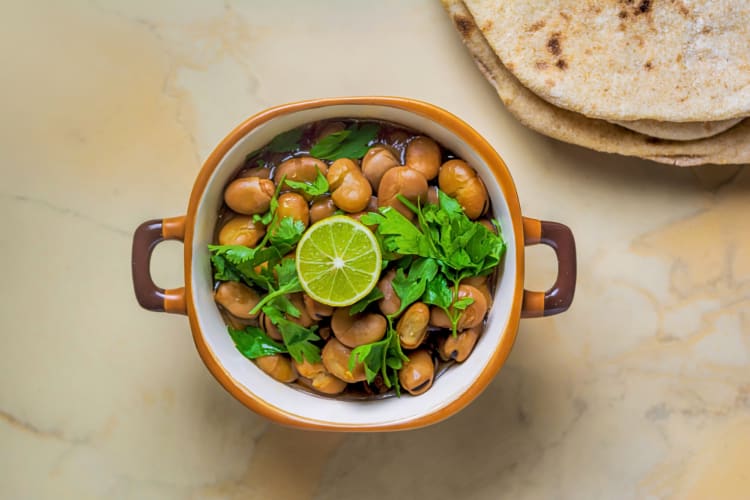
Learn To Cook Middle Eastern Foods
Taking cooking classes in Abu Dhabi and cooking classes in Dubai is a fantastic way to immerse yourself in the rich culinary traditions of the region while traveling through the Middle East. Recipes for Middle Eastern foods can often be daunting, and these classes offer hands-on experiences with local chefs guiding you through preparing authentic dishes.
From fragrant spices to traditional cooking techniques, these classes break down complicated steps and allow you to truly connect with the culture behind each dish. Whether you’re mastering the art of making soft, pliable manakeesh, perfecting the layers of a honey-drenched baklawa or balancing the bold flavors of a meaty kebab, cooking classes can hone skills and bring the stories behind the food to life.
But you don’t have to wait for your next trip to experience these flavors; you can find cooking classes near you that focus on Middle Eastern cuisine, or better yet, join online cooking classes from the comfort of your kitchen. These options make it easy to learn how to prepare delicious, authentic dishes at home, so you can bring the flavors of the best Middle Eastern foods to your table anytime you want.

Whether you’re traveling to the Middle East or experimenting from home, learning to cook Middle Eastern foods opens up a world of vibrant flavors and rich traditions. These dishes bring people together and offer a delicious way to experience something new.
By opening your mind to traditional recipes that look and sound foreign, you not only enjoy incredible meals but also carry a piece of this remarkable culinary heritage with you. Embrace the adventure of enjoying Middle Eastern foods and begin your journey to unforgettable tastes and experiences.
For even more ways to explore your favorite foods, check out other experiences happening on Cozymeal.



FOOD FOR THOUGHT?
Join the conversation.